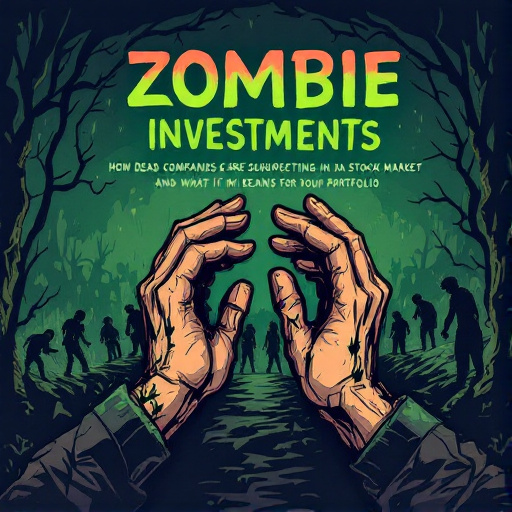Featured Articles
- Ghost Investing: How Haunted Real Estate Could Be Your Next Unlikely Asset Class
- Investing in Chaos: How Political Turmoil Drives Unexpected Market Opportunities
- Investing in Dreamscapes: The Rise of Virtual Real Estate and Its Untapped Value مص
- Investing in the Underworld: How Dark Money Shapes the Future of Finance
- "Investing in Your Future: How Micro-Businesses are the New Gold Mines in a Post-Pandemic Economy"
Zombie Investments: How Dead Companies are Resurrecting in the Stock Market and What It Means for Your Portfolio
Zombie Investments: How Dead Companies are Resurrecting in the Stock Market and What It Means for Your Portfolio
The phenomenon of "zombie investments" refers to dead or struggling companies that somehow find their way back into stock market relevance, often enticing investors. This article explores the implications of such investments on your portfolio, delving into case studies, risks, and strategies for navigating this unconventional market landscape.
The Zombie Apocalypse: Stock Market Edition
Picture this: it's a quiet Tuesday afternoon when you hear news of an old company—let's say, Blockbuster—unexpectedly soaring in stock price. In an age where streaming services dominate our screens, how can an ancient video rental franchise still pique investor interest? This is the mysterious allure of zombie investments; they rise from the grave with tales of revival, and the market dances to their tune.
What Are Zombie Investments?
Simply put, zombie investments refer to companies that are functionally dead or in a state of perpetual decline yet manage to hang around in the stock market—think of them as the undead of the corporate world. According to a 2021 report by the Bank of America, around 16% of publicly traded companies in the U.S. have become zombies, unable to cover their interest payments with earnings. These firms often have a market capitalization, drawing in naive investors who believe in a miraculous turnaround.
Why Do Zombies Rise?
But why do these financial corpses keep popping up? The answer lies in market psychology, investor behavior, and sometimes sheer luck. For starters, there’s the fundamental speculating nature of investors. In an uncertain world, the allure of a "turnaround story" can be irresistible. Investors often believe they can find value where others see waste, especially with the introduction of meme stocks in 2021, where companies like AMC and GameStop rallied back from the brink thanks to the tireless effort of retail investors mobilized through social media.
Case Studies: The Invincible Undead
Consider the case of Hertz. In 2020, the rental car company filed for bankruptcy, sinking under the weight of the pandemic. Yet, barely a year later, Hertz’s stock skyrocketed, appealing to investors hungry for bargains. Companies on the brink genuinely won’t die unless they are met with a serious, often immediate, threat, like being delisted or failing to raise capital. Even post-bankruptcy, they can rebound, fueled perhaps by investors’ collective desires or renewed business strategies.
Lessons from the Grave: What Can Investors Learn?
Now, there are critical lessons to unearth from these zombie investments. First, conduct foundational research. Examination of fundamentals like profitability and cash flow is imperative, even for firms perceived as "dead." Numbers don’t lie, dear reader! Past performance might not guarantee future results, but astute observation can help recognize when to sniff out genuine revival potential.
The Risks of Investing in Zombies
Of course, investing in these undead monsters carries substantial risks. Picture indulging in a game of roulette where stakes are heightened. Did you know that according to research by the Financial Times, 75% of zombie companies never recover? And that figure should scream at any investor. While some might rise, the majority could lead your portfolio to a somber grave, bound to leave regret in their wake.
Zombie Investments: A New Investment Strategy?
In the wake of these investing possibilities, could zombie stocks be their own legitimate sector? Think of it as a niche market in a broader strategy. By allocating a small portion of your overall investment in these companies, you may be able to achieve substantial short-term gains—if you play your cards right. Just remember to hedge your bets and not pour your life savings into the latest reincarnation of a long-lost company.
Survival of the Fittest: Diversifying Your Portfolio
When considering zombie investments, diversification should be at the forefront of your strategy. It’s akin to balancing a cheesy horror movie with a classic romantic comedy; you need both the thrill and the comfort. By spreading your investments across various sectors—both living and undead—you increase the chances of favorable returns while mitigating potential losses incurred from one particularly grim investment choice.
The Social Media Influence
One cannot overlook the role that social media plays in enhancing the zombie phenomenon. Platforms like Reddit and Twitter provide a space for retail investors to band together like zombies at a rave, pushing stock prices up exponentially through sheer communal sentiment. This “meme stock” culture often resurrects companies that would otherwise lie dormant, prompting investors—and even analysts—to pay attention.
Engaging with Your Inner Analyst: Tools to Help You
If you’re leaning into the world of zombie stocks, having the right tools at your disposal can make or break your investment experience. Utilize platforms like Finviz or Yahoo Finance for essential financial metrics. Armed with knowledge, you will engage with these investments as if you were a detective unraveling a cryptic mystery. Financial health, insider trading activity, and market sentiment should all be part of your due diligence toolkit.
The Ghost of the Past: Companies that Made a Comeback
Let’s unpack some interesting success stories that offer hope to the aspiring zombie investors. One standout example is Kodak. Once a titan of photography, Kodak famously failed to pivot during the tech boom but later saw a stock surge due to diversification into pharmaceuticals and manufacturing. Each such tale is a reminder that the past need not dictate the future, as long as strategic moves are at play.
Beware of Walking Zombies: Key Indicators
Investing in zombie companies shouldn’t be devoid of caution. Watch out for specific red flags—like increasing debt levels, negative cash flow, or continuous layoffs. These indicators, like a haunted house with flickering lights, should warn you of impending doom ahead. Whenever possible, conduct interviews or seek insider opinions; sometimes, those closest to an organization can provide insights that numbers simply do not reveal.
Let’s Have a Coffee: The Investor’s Mindset
Hey there, curious investor! As we sip our lattes and ponder our financial futures, consider this: investing isn't just about money; it’s also about mindset. When diving into zombie investments, it's crucial to approach them with an open yet skeptical mind. After all, you don’t want to drown in a sea of regret as you watch these investments oscillate like a horror movie plot twist.
Zombies in the Future: What’s Next?
Looking forward, how will the future of zombie investments evolve? With the increasing rise of AI technologies and automation, are we soon to see new entities rise from the ashes with higher success rates? The future landscape could be significantly different and so should our investment strategies. It’s essential to stay ahead of the wave and be prepared for these possible shifts, ensuring your portfolio remains resilient.
Conclusion: An Investment in Caution
In the end, while the intrigue of zombie investments often drums up excitement, a level-headed approach is vital. Balancing risks with potential rewards and diversifying your portfolio will allow you to navigate both the heady excitement and the potential pitfalls of these flashy stocks. Zombie investing may be a rollercoaster ride of thrills, chills, and occasional spills, but with careful groundwork, you might just find yourself in the front row of this unique financial entertainment. Ready or not, the undead are waiting—will you join them?




